Class 10 Exam > Class 10 Notes > Biology for GCSE/IGCSE > Genetic Modification
Genetic Modification | Biology for GCSE/IGCSE - Class 10 PDF Download
Genetic Modification: Definition
- Genetic modification involves altering the genetic makeup of an organism by adding, removing, or changing individual genes sourced from another organism.
- This process results in the creation of a genetically modified organism, also known as a transgenic organism.
- The genetic material of the modified organism, which now includes DNA from a different organism, is referred to as recombinant DNA.
Genetic Modification: Examples
- Genetically Modified Organisms: Genetically modified organisms (GMOs) are living organisms whose genetic material has been artificially altered in a laboratory through genetic engineering techniques.
- Human Insulin Production: One example of genetic modification is the production of human insulin by inserting the gene responsible for insulin production into bacteria. These genetically modified bacteria can then produce insulin, which is collected and purified for medical use, particularly for diabetic patients.
- Insect-Resistant Crop Plants: Certain crop plants like wheat and maize have been genetically modified to contain genes from bacteria that produce toxins harmful to insects. This modification makes these plants resistant to insect pests such as caterpillars, reducing the need for chemical insecticides.
- Herbicide-Resistant Crops: Another application of genetic modification is creating crop plants that are resistant to specific herbicides. This modification allows farmers to spray herbicides on their fields to kill weeds without affecting the crop plants, enhancing weed control.
- Vitamin-Enhanced Crops: Some crops have been genetically modified to produce additional vitamins. For instance, 'golden rice' has been engineered to contain genes from other plants and bacteria, enabling the production of a compound that converts into vitamin A in the human body. This innovation aims to combat vitamin A deficiency in certain regions.
Genetic Modification: Examples
- The desired gene is taken from the original organism. For instance, this could involve extracting the gene responsible for producing human insulin.
- Special enzymes called restriction enzymes are employed to extract the specific gene. These enzymes leave the gene with what are known as 'sticky ends', which are short sections of unpaired bases.
- A circular piece of DNA known as a bacterial plasmid is then cut using the same restriction enzyme, resulting in it having complementary sticky ends. Plasmids are circular DNA structures typically found within bacterial cells.
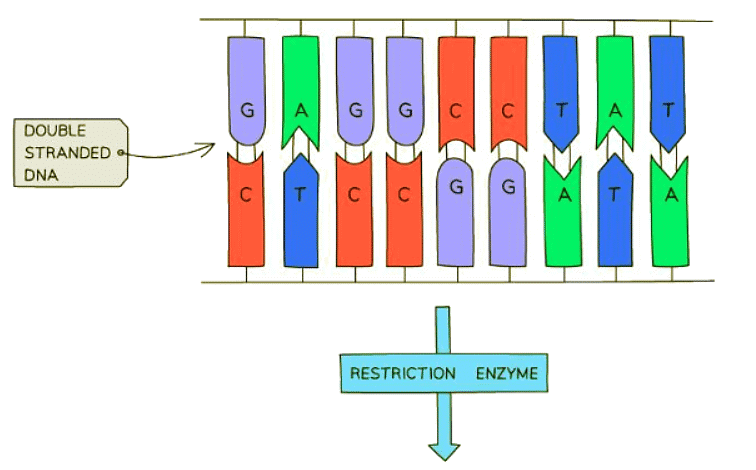
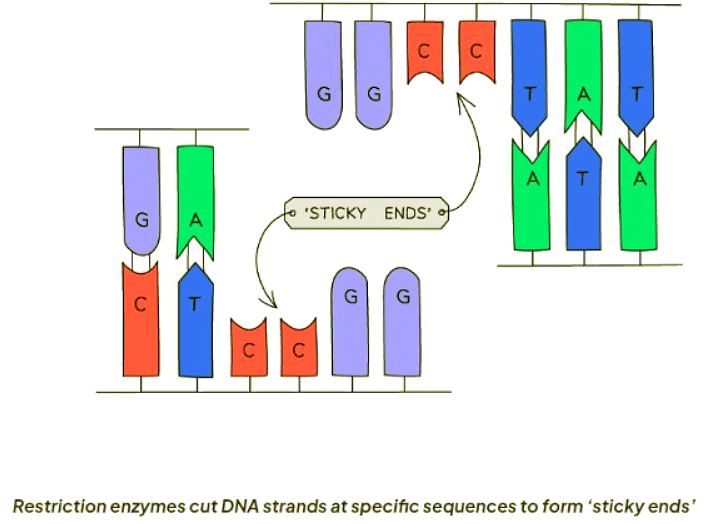
- When a plasmid and an isolated gene are brought together, they are connected by the DNA ligase enzyme.
- DNA ligase functions by linking two DNA fragments with matching sticky ends created by the same restriction enzyme, forming a continuous DNA molecule.
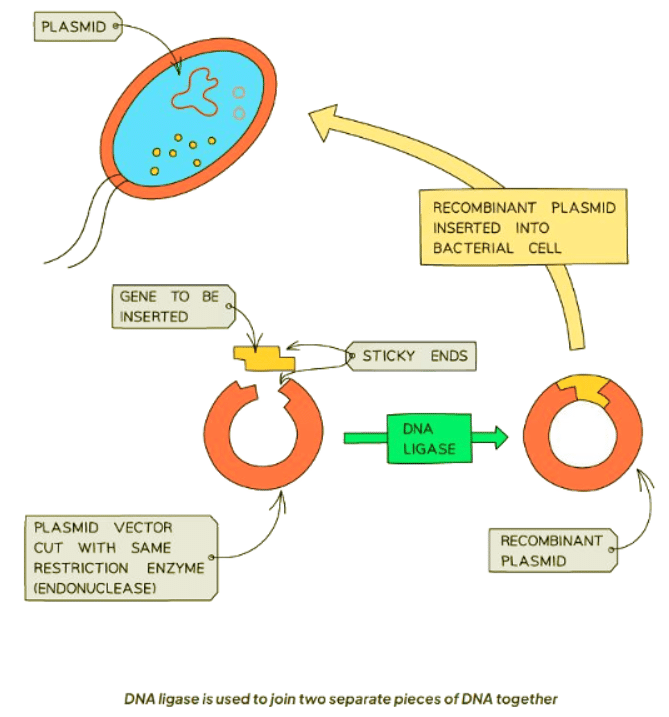
- The process involves inserting a genetically engineered plasmid into a bacterial cell.
- Upon reproduction, the plasmids are replicated, facilitating the rapid spread of the recombinant plasmid as the bacteria multiply. Consequently, all bacteria express the desired gene, producing the human protein.
- Genetically modified bacteria can be cultivated in a fermenter under controlled conditions to accelerate reproduction and generate large amounts of the human protein.
- Bacteria are particularly favored for genetic engineering due to several reasons:
- They possess the same genetic code as the source organisms, allowing for easy interpretation and protein production.
- Unlike animals, there are no ethical concerns associated with manipulating and growing bacteria, as they lack the capacity to experience pain or distress.
- The presence of plasmids in bacteria, distinct from the main bacterial chromosome, simplifies the process of gene insertion and manipulation before reintroducing them into bacterial cells.
GM Crops
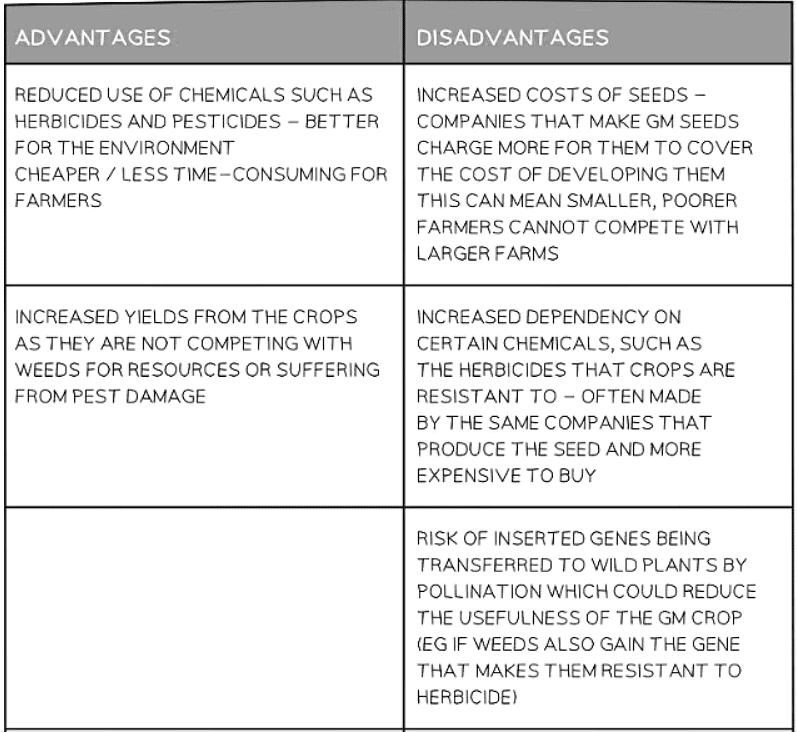
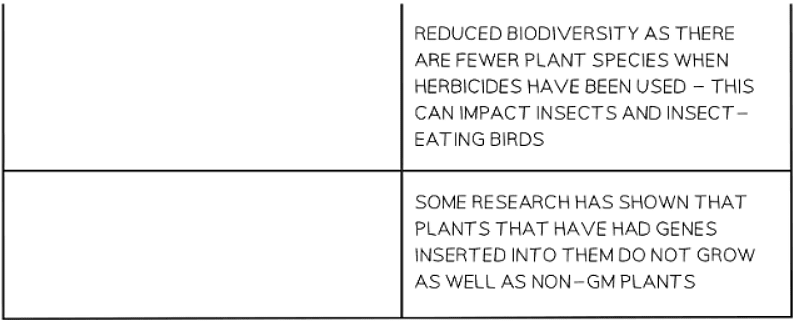
Question for Genetic ModificationTry yourself: Which of the following is an example of genetic modification?View Solution
The document Genetic Modification | Biology for GCSE/IGCSE - Class 10 is a part of the Class 10 Course Biology for GCSE/IGCSE.
All you need of Class 10 at this link: Class 10
|
101 videos|193 docs|33 tests
|
FAQs on Genetic Modification - Biology for GCSE/IGCSE - Class 10
| 1. What is genetic modification? |  |
Ans. Genetic modification is the process of altering an organism's genetic material to introduce new traits or characteristics.
| 2. Can you provide examples of genetic modification? |  |
Ans. Examples of genetic modification include genetically modified crops, such as corn and soybeans, genetically modified animals like salmon, and genetically modified bacteria used in pharmaceutical production.
| 3. What are GM crops? |  |
Ans. GM crops are plants that have been genetically modified to resist pests, diseases, or herbicides, or to improve nutrient content or yield.
| 4. How long have GM crops been in existence? |  |
Ans. GM crops have been in existence since the mid-1990s when the first genetically modified crops, such as insect-resistant cotton and herbicide-tolerant soybeans, were commercialized.
| 5. Are there any potential risks associated with genetic modification? |  |
Ans. Some potential risks of genetic modification include the unintended transfer of genes to non-target species, the development of resistant pests or weeds, and the impact on biodiversity.
Related Searches















